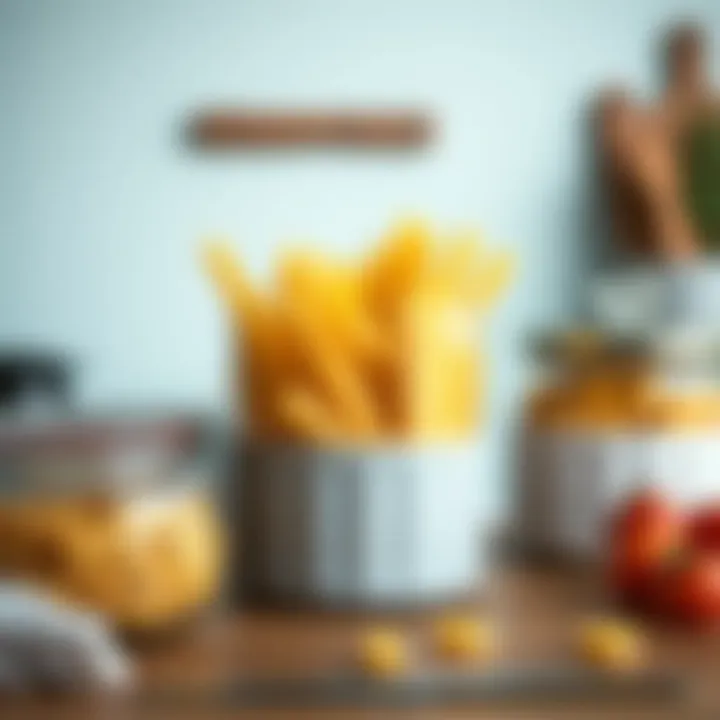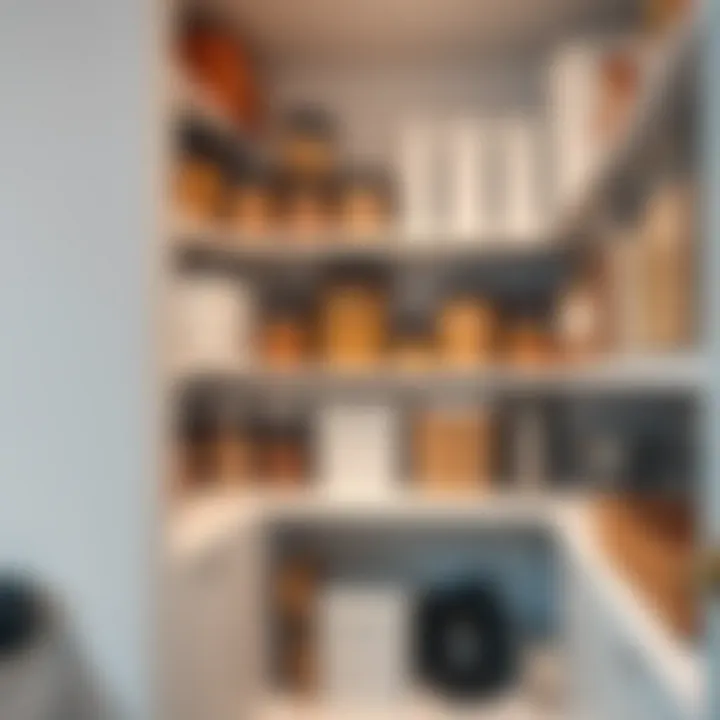Storage Solutions for Cereal and Pasta Containers


Intro
When it comes to organizing the heart of any home, the kitchen stands out — and within it, the pantry often proves to be a treasure trove waiting to be optimized. Storage solutions can make or break this vital space, especially for staples like cereal and pasta that we rely on daily. The choices spanning from the type of container to its design can significantly affect both freshness and accessibility.
Many homeowners and culinary connoisseurs might not realize the degree to which proper storage enhances food longevity and kitchen aesthetics. This is not just about tossing things into any old jar; it requires strategic selection and careful considerations. A well-thought-out container system can ultimately lead to a more functional and attractive kitchen.
This comprehensive guide aims to unpack the essential elements involved in choosing the right containers for cereal and pasta. From current design trends that harmonize functionality with style, to material innovations that cater to both environmental and practical concerns, we're covering it all. Whether you're hosting a dinner party or merely enjoying a bowl for yourself, the impact of your storage solutions cannot be overstated.
Let's dive into the world of innovative storage options that keep those pantry essentials fresh while enhancing the overall aesthetic of your kitchen.
The Significance of Proper Food Storage
Food storage may sound like a mundane topic, but it carries significant weight when it comes to maintaining quality and efficiency in the kitchen. Proper food storage not only preserves the freshness and flavor of your ingredients but also plays a crucial role in minimizing waste. As kitchen enthusiasts or homeowners, understanding the significance of food storage can create a more organized, sustainable, and enjoyable cooking environment.
Preserving Freshness and Flavor
Keeping your cereals and pastas in prime condition requires more than just tossing them in any container. Proper storage is an art as much as it’s a science. When food is stored incorrectly, it can lose its fresh taste. For instance, sometimes storing pasta in a humid environment can soften it and promote the growth of mold. By using airtight containers, you can protect these staples from moisture and air, two culprits of spoilage. And let’s not forget, the taste of stale cereal can be as unbearable as a soggy sandwich.
Moreover, freshness isn’t just about taste; it affects texture as well. Pasta that’s left exposed can become brittle or chewy instead of that delightful al dente we all crave. So, put your best foot forward and invest in quality storage solutions that ensure every bowl of cereal is as crisp as intended.
Reducing Food Waste
Statistics show that millions of tons of food go to waste each year. We’re not just talking about fruits and vegetables; dry goods like pasta and cereal are often overlooked when it comes to waste management. Improper storage can lead to accelerated spoilage, which means your hard-earned money goes down the drain. Take the time to store your pantry essentials correctly, and you’ll likely notice a significant reduction in what you toss out.
Employing labeling systems, too, aids in tracking expiration dates. Keeping a close eye on what you have on hand can help avoid unnecessary purchases. Reducing food waste doesn’t have to be a Herculean task; a little organization can go a long way.
Enhancing Kitchen Organization
An organized kitchen is like a well-tuned orchestra; it plays a harmonious role in meal preparation. When everything has its place, finding a box of pasta or a bag of cereal becomes a breeze. Clear containers are particularly valuable as they provide visibility at a glance, enabling you to locate ingredients without rummaging through clutter.
This way, not only does your kitchen look tidier, but you also save precious time. An artful arrangement of containers can transition a chaotic pantry into a visually pleasing display, elevating your culinary space from a simple cooking area to a chic gallery of staples. Strategies like stacking storage bins or utilizing different sizes can maximize space, giving your cabinets a fresh lease on life.
Types of Containers for Cereal and Pasta
When it comes to storing cereal and pasta, selecting the right type of container plays a crucial role in maintaining food quality and freshness. The choices you make can influence not just safety but also convenience in your everyday cooking and serving. Choosing the right material, be it plastic, glass, metal, or ceramic, will have far-reaching implications for your pantry organization and the way you enjoy your food.
Plastic Containers
Plastic containers are a common choice, prized for their versatility and accessibility. With a multitude of options available, they often suit various needs, preferences, and budgets.
Durability
One of the key attributes of plastic containers is their durability. These containers are often designed to withstand everyday wear and tear. Unlike glass or ceramic, they are less prone to cracking or breaking, making them ideal for households with kids. Plus, many plastic containers are lightweight, so moving them around is a cinch. In this sense, durability adds immense value—particularly in a busy kitchen environment where accidents could happen.
BPA-free Options
Among the most significant concerns with plastic containers is the potential presence of BPA, a chemical often used in manufacturing. However, an increasing number of brands offer BPA-free options. These containers allow consumers to enjoy the same benefits of plastic without the worry of harmful chemicals leaching into food. BPA-free plastic serves the dual function of safety and practicality, ensuring that you can stomach the contents without a second thought.
Color and Design Variability
What makes plastic containers particularly appealing is their color and design variability. Available in myriad hues and styles, they can blend effortlessly into any kitchen aesthetic. This adaptability encourages consumers to choose options that not only meet functional needs but also enhance visual appeal. However, while aesthetics can be a selling point, not all designs will offer the same level of functionality, and one should keep an eye on ease of use.
Glass Containers
Glass containers have gained traction due to their timeless appeal and health benefits. They are often regarded as the more sophisticated option for food storage.
Aesthetic Appeal
The aesthetic appeal of glass containers is hard to overlook. They provide a sleek, clean look that can elevate the general ambiance of any kitchen. The transparency allows you to see the contents easily, which not only adds to their practicality but also makes them perfect for displaying beautiful pantry items. Their eye-catching appearance can be a conversation starter during casual gatherings.
Non-reactive Storage
Glass is known for being non-reactive, making it an excellent choice to store various kinds of food, including acidic items. This characteristic ensures that the food’s flavor won’t be impacted by the container itself, unlike plastic, which may absorb odors or chemicals. Thus, for those who prioritize food integrity, this quality is invaluable.
Sustainability


In a world increasingly focused on sustainability, glass scores high marks due to its recyclability. Glass containers can be reused multiple times without losing integrity, and when disposed of, they can be recycled indefinitely. Because of this, they appeal to eco-conscious consumers looking to minimize their environmental footprint. Still, they tend to be more fragile, which is a downside for some, especially in homes with children.
Metal Containers
Metal containers are another robust option, delivering durability and an interesting aesthetic.
Longevity
The longevity of metal containers makes them a worthwhile investment. Resistant to rust and corrosion, especially when made from stainless steel, these containers offer solid protection against the elements both inside and outside your pantry. As a one-time purchase, it can save you money over time.
Rust Resistance
Metal, particularly stainless steel, is designed for rust resistance. This quality is essential for maintaining quality over long periods. When storing dry goods like pasta or cereal, rust can be a game changer in keeping goods fresh and edible. The absence of rust means that you’ll avoid any unpleasant surprises when reaching for that box of pasta three months later.
Storage Capability
Another distinct advantage of metal containers lies in their storage capability. These containers often come in larger sizes and can be stacked or nested, optimizing pantry space effectively. While they may not be as visually appealing as glass or ceramic, their functionality usually trumps aesthetic considerations.
Ceramic Containers
Ceramic containers bring an element of charm and warmth to the kitchen, appealing to those with a penchant for traditional or rustic styles.
Design Diversity
One of the notable features of ceramic containers is their design diversity. Ranging from hand-painted pieces to sleek modern lines, they can complement a wide range of decor styles. This versatility allows homeowners to express a distinct aesthetic while maintaining functionality.
Weight Considerations
In contrast to plastic and metal, ceramic containers tend to be heavier. This weight consideration can be a double-edged sword; it provides stability, but it might not be suitable for everyone, particularly those who prefer lightweight options for ease of use during meal prep.
Fragility
A significant downside to ceramic containers is their fragility. Easily breakable, they require extra care, particularly in busy kitchens. Despite this, their beauty often outweighs the risks for many who appreciate their unique style. However, this factor cannot be ignored when selecting containers for a household with little ones or a fast-paced lifestyle.
Each of these container types offers unique attributes that cater to various needs and preferences. Being aware of each option's pros and cons allows homeowners and culinary enthusiasts alike to optimize their storage solutions effectively.
Key Features to Consider When Choosing Containers
Choosing the right container for storing cereal and pasta may seem trivial, yet the right features can make a world of difference. Food storage is not just about keeping things fresh; it's also about organization and usability. When selecting containers, several key elements should be fleshed out, including airtight seals, transparent materials, and space efficiency. These aspects play a pivotal role in preserving the quality of your pantry staples while enhancing your kitchen's functionality.
Airtight Seals
Airtight seals are truly indispensable for anyone keen on keeping their food fresh. Unlike conventional lids, these seals are designed to lock out air, moisture, and pests. If you ever had a bag of cereal turn stale because of moisture, you’ll understand the brilliance of an airtight design. Properly sealed containers help to maintain the food's crispness and flavor for an extended duration.
Moreover, these seals often assist in retaining original aromas. Imagine opening a container of pasta that still smells like it just came from the mill. This not only contributes to a better eating experience but can also save you money in the long run as food stays fresher, longer. To sum it up: the advice is clear—opt for containers that sport airtight seals for your grains and pasta.
Transparent Materials
Transparency in food storage containers is popular for a good reason. First up is Visibility of Contents. You can quickly see what's inside without having to open each container. When you’re in a rush to dinner or breakfast, this quick glance can save valuable moments, allowing you to grab what you need without delay.
Another perk that comes with transparent materials is the aesthetic appeal. Clear containers can contribute to a certain organizational beauty in your pantry. However, there's a caveat; while visibility is inviting, if the contents get too cluttered or the containers aren’t often cleaned, they can appear unkempt. Cleanliness and organization often go hand in hand.
Convenience
When discussing convenience in the context of storage containers, the key notion is accessibility. Easy to open, clean, and refill containers make the cooking process smoother. Who hasn’t found a container lid that challenges the laws of physics when trying to twist it off? Look for designs that integrate user-friendly features such as easy-grip lids or flip-top openings. Their usability cannot be overstated, as it can significantly cut down the time spent rummaging through your pantry.
Of course, it is essential to choose containers that are also dishwasher safe. This detail adds another layer of convenience. In essence, convenience plays a crucial role in ensuring you’ll actually utilize those containers instead of opting for whatever’s easiest at hand.
Space Efficiency
In today’s kitchens, where space can often be at a premium, the notion of space efficiency can’t be overlooked. Features like Stackability can create vertical space in your pantry, allowing you to store more in less area. Stackable containers allow you to utilize height instead of spreading items out, which commonly leads to clutter.
They can also be part of a coherent design plan. For instance, if you have a set of uniform stackable containers, it creates a visually pleasing arrangement, giving your pantry a tidy appearance. But do be cautious; overly tall stackable containers can be tricky to manage, especially if they become top-heavy.
Nesting Design
Then, there’s the Nesting Design, a clever way to save space when containers are not in use. Stackable designs do wonders, but nesting designs take it even further by allowing containers to fit neatly inside one another. Many of us have dealt with containers that take up too much room in our cabinets or pantry. Nesting designs maximize storage without waste. This makes them a smart investment, particularly for those who may not have the luxury of expansive kitchen space.


While they save space efficiently, nesting containers can sometimes sacrifice individual usability. You may need to sift through multiple containers to find the one you want when they are stacked in tight. Design choices in this realm become crucial in striking a balance.
Ultimately, the features discussed—airtight seals, transparent materials, and considerations for space efficiency—are crucial when selecting containers for cereal and pasta. These features collectively enhance pantry organization, thus simplifying your cooking processes and maintaining food quality.
Design Considerations for Kitchen Aesthetics
Creating a kitchen that is not only functional but also visually appealing is essential for many homeowners and culinary enthusiasts. In this section, we explore how design considerations for containers used in storing cereal and pasta can play a significant role in enhancing overall kitchen aesthetics. A well-organized kitchen with stylish containers reflects the personality of the home and can even elevate the cooking experience. When selecting these storage solutions, it's crucial to think beyond practicality and consider how they contribute to the room's décor.
Color Coordination
Color coordination can transform a simple storage solution into a visual highlight of your kitchen. Opting for containers that complement or contrast strikingly with your kitchen's color palette allows for creative expressions. For example, if your kitchen sports a soothing palette of whites and grays, vibrant red or green containers can serve as eye-catching accents. Alternatively, if your kitchen is already filled with bold colors, neutral or pastels might enhance the overall look without overwhelming the space.
Moreover, seasonal adjustments can keep your kitchen fresh. Swapping out containers based on seasons—perhaps earthy tones for autumn or bright, fresh colors for spring—adds a dynamic touch without extensive renovations. This not only keeps things visually interesting but encourages homeowners to engage with their kitchen space more interactively.
Style Consistency
Maintaining style consistency across kitchen elements helps create a harmonious environment. If the rest of your kitchen holds a modern chic vibe, sticking with sleek, minimalist containers becomes vital. On the other hand, if your space embodies a rustic charm, consider containers made from wood or ceramic with earthy tones and textured finishes. This uniformity in style doesn’t just elevate aesthetics; it also creates an environment that feels intentional and curated rather than haphazard.
In this regard, integrating containers into your kitchen design doesn't have to be an afterthought—it can be a key feature that ties the whole space together. Avoid mixing wildly different styles, as this can lead to a chaotic visual experience.
Labeling Systems
Functionality
Labeling systems marry functionality with style. Clearly marked containers allow for quick identification of what’s inside and can significantly enhance organization within the kitchen. This is invaluable for saving time, especially in busy households where each second counts. A well-placed label can indicate that a container holds whole wheat pasta or gluten-free cereal, making meal prep seamless and straightforward.
The standout characteristic of a practical labeling system is its versatility. Labels can be custom-made using various methods—chalkboard paint, printouts, or even artistic handwriting that enhances the decorative appeal. It makes the kitchen come alive and ensures that every item has its dedicated space. While some may prefer a more rugged look with handwritten labels, others might opt for a more polished appearance using printed fonts.
The advantage here is clear: labeling not only helps maintain order but can also be aesthetically pleasing if harmonized with the overall kitchen setup. However, inconsistent or boring labels can detract from aesthetic appeal, so it's important to choose styles that fit the overall theme.
Design Integration
The integration of labels into the container design further elevates the aesthetic value. Having labels that match the color scheme or styling of the containers can create a cohesive look that may even look like a part of the container design itself. For example, if you are using glass containers with a silver lid, opting for metallic labels adds an element of sophistication.
This specific design integration allows features to blend with overall aesthetics, making them feel intentional rather than merely functional. In kitchens where every detail has been considered, even labels become part of the artistic expression.
For more tips on kitchen aesthetics, consider browsing resources like Wikipedia or Britannica.
Best Practices for Organizing Your Pantry
Organizing a pantry might sound trivial, but it's akin to painting a masterpiece on a blank canvas. The arrangement of each shelf not only impacts functionality but also affects the entire kitchen's aesthetic. Good organization of your pantry can lead to minimized food waste, easier access to stored items, and overall heightened cooking efficiency. This section will dive into practical methods to group your pantry contents, use transparent containers for maximum visibility, and maintain a system that keeps your foods fresh.
Grouping Similar Items
Think about what the heartbeat of your pantry is. Generally, it's all about grouping similar items together. By clustering cereals in one corner and pastas in another, you create an intuitive layout that allows you to easily locate what you're searching for. Consider creating categories like breakfast items, snacks, baking necessities, and cooking inclusions.
- Pro Tip: Label the shelf or the containers, so every family member knows where to find the granola or whole wheat spaghetti. This reduces rummaging around, making the morning routine a bit less chaotic.
Additionally, grouping can limit the chances of buying duplicates—ever bought that box of organic oats only to find three more hiding in the back? You can think of grouping as building a well-organized library; every item has its designated space.
Using Clear Containers for Visibility
Visibility is key in maintaining an organized pantry. Using clear containers for cereals and pasta will do wonders. When everything's in plain sight, you're taking away a layer of inconvenience that can lead to expired items or forgotten snacks.
- Benefits of Clear Containers:
- You can easily spot when you're running low on ingredients.
- They help with portion control since you’ll see how much you truly have.
- The aesthetic appeal of clear glass can enhance your kitchen's look—think of it like trendy decor.
“Out of sight, out of mind” doesn’t have to be the mantra of your pantry anymore. Build a well-planned visibility strategy, and your pantry will practically organize itself, or feel like it.
Establishing a First-In, First-Out System
If efficiency is the game, then the First-In, First-Out (FIFO) method is your strategy. This is particularly necessary for items with a shelf life, such as cereals and pastas. By ensuring that older items are used first, you'll prevent those pesky expiration dates from sneaking up on you.
- How to Implement FIFO:
- When adding new items, place them behind or under the older stock.
- Rotate your stock periodically to make sure no box gets left behind.
- Consider using some of those clear containers to keep track of dates.


It's a small change that makes a big impact. Applying FIFO means less waste, lower grocery bills, and the peace of mind that comes with knowing you’re using your pantry supplies efficiently.
By following these best practices, not only will you streamline your cooking process, but you'll also contribute to a more harmonious kitchen environment. Embrace these methods and watch as your pantry transforms from a chaotic space into a well-oiled machine.
Innovative Trends in Food Storage Containers
In recent years, food storage has seen a significant evolution, shifting from traditional containers to more innovative solutions that address both functionality and modern consumer needs. Smart containers, sustainable options, and multi-functional designs are leading the charge, offering solutions that are not just practical but also environmentally conscious and adaptable to various culinary lifestyles.
Smart Containers
Technology Integration
The rise of smart technology in our homes has permeated the kitchen, and food storage containers are no exception. With advancements in technology integration, these containers can now monitor humidity and temperature, ensuring optimal storage conditions for cereal and pasta. A key characteristic of these smart containers is their ability to connect to mobile applications, allowing users to track supply levels and set reminders for replenishing when stocks run low. This is particularly beneficial for busy households where organization can often take a backseat.
A standout feature of these smart systems is their compatibility with various home automation setups. Customers find that being able to control their kitchen inventory from a smartphone provides a level of convenience that traditional storage simply can't match. However, potential downsides include the need for charging these containers, which could lead to an added layer of hassle for some users.
Food Tracking Applications
Food tracking applications represent another integral aspect of smart containers, bringing an enhanced level of awareness to what goes in and out of your pantry. These apps allow users to monitor not just quantities but also expiration dates, creating reminders that help in minimizing waste. A noteworthy characteristic of these applications is their capability to sync with recipes, guiding consumers on how to utilize what they have on hand effectively.
The unique feature of integrating food tracking apps with containers is their ability to provide personalized recommendations based on past consumption patterns. This means users can receive suggestions that align with their tastes, potentially introducing them to new dishes and minimizing food leftovers. On the downside, reliance on technology may be a barrier for those not comfortable with apps, limiting the accessibility of such benefits.
Sustainable Options
Recycled Materials
With growing environmental awareness, containers made from recycled materials have seen a surge in popularity. These products contribute not just to reducing plastic waste but also present an ethical choice for consumers who are keen on sustainability. A primary characteristic of recycled materials is that they often maintain durability comparable to traditional plastic alternatives while helping in curbing ecological footprints.
These containers typically sport modern designs which resonate well with eco-conscious shoppers, thus appealing to a niche market in home goods. A notable advantage lies in their ability to spark conversations around sustainability, making them worthy not just functional items but also statements about lifestyle choices. However, it’s important to consider that while often made from reliable materials, the longevity of some recycled products may not reach the standards of high-end counterparts.
Ecosystem Considerations
When discussing modern food storage, considering the ecosystem impacts is crucial. Sustainable practices go beyond just the use of recycled materials; it involves assessing the entire lifecycle of a product. Containers created with ecosystem considerations in mind are designed proactively to reduce impacts, from sourcing raw materials to energy spent in manufacturing.
A key feature of these products is their focus on achieving sustainability without compromising on aesthetics or functionality. The broad appeal comes from their alignment with a larger vision for environmental health. However, a challenge may arise when these products command a premium price, making them less accessible for some consumers looking for budget-friendly options.
Multi-functional Designs
Dual-purpose Containers
Dual-purpose containers are becoming increasingly popular in today's multifunctional homes. These containers can serve multiple roles, such as storage for dry goods while also transforming into serving dishes. The key characteristic that makes them appealing is their versatility—reducing the number of items needed in the kitchen and, in turn, saving valuable space.
The unique feature of dual-purpose designs lies in their adaptability; they can shift from pantry to table with ease, making them ideal for gatherings or unplanned dinners. While this might save space, it is important to note that users may have to sacrifice some specific functionalities in each role, sometimes resulting in a compromise on the quality of storage or serving.
Adaptable Storage Solutions
Adaptable storage solutions take versatility a step further by allowing users to customize configurations based on current needs. These designs often come with modular components that can expand, contract, or even change shape as required. The main characteristic here is their fluidity; the ability to alter their shape or arrangement caters to unique pantry layouts and personal preferences.
A standout feature of these adaptable solutions is that they encourage creativity in kitchen organization, allowing for bespoke setups that directly correlate to personal habits. On the flip side, the initial investment might be higher compared to traditional options, but many see it as a worthwhile investment for long-term organization.
In summary, embracing innovative trends in food storage containers offers concrete advantages that align with contemporary living. Various aspects of these innovative designs not only serve practical needs but also resonate with sustainable practices and the desire for flexibility in modern households. Whether it's through technology and smart systems or eco-friendly materials and multi-functional designs, these trends are setting the stage for a future-focused approach to kitchen organization.
The End: The Future of Food Storage Container Design
When reflecting on food storage for cereal and pasta, one must recognize how essential container design is to both functionality and aesthetics. In a world where kitchen space is often at a premium, the containers we choose can either make or break our culinary organization. As we progress into a future dominated by innovation and design flair, it's crucial to keep in mind a few key elements that will shape the trajectory of food storage containers.
Balancing Functionality with Aesthetics
The intersection of form and function defines the best kitchen products. The modern consumer does not merely seek a container that serves its purpose; they crave items that enhance the overall kitchen ambiance. Consider how a chic glass jar filled with whole grain pasta can stand as an art piece, drawing the eye while being entirely functional.
- User Experience: A thoughtful design improves usability. For example, well-designed lids that offer an airtight seal make great choices as they can keep contents fresh while making it easy for users to pour precisely without spillage.
- Materials Matter: Materials such as glass or stainless steel provide durability and can enhance the visual appeal of any pantry. Both options, though different, offer a sleekness that complements various design styles from rustic to ultra-modern.
- Space Optimization: Stackable containers can free up valuable counter space and add a chic layered appearance. Walls of towering containers can create a striking visual that draws attention but doesn’t obstruct access.
"A container should do its job while looking good; that is true art of kitchen design."
This balance fosters not just practicality but also elevates the daily cooking experience by combining the beauty of carefully curated kitchenware with unmatched utility.
Adapting to Consumer Preferences
As societal norms shift, so do consumer preferences in food storage solutions. More than ever, buyers are inclined towards products that reflect their values and lifestyles.
- Sustainability Concerns: Eco-friendly materials are becoming critical. Brands that use recycled plastics or sustainably sourced wood will gain traction among eco-conscious consumers. Not only do these options help in reducing carbon footprints, but they also appeal to customers wanting to make conscientious choices.
- Smart Technology: Another layer of modernity is the integration of technology. Smart containers that can alert users about expiration dates or quantities left in a container add a new dimension of convenience.
- Customization: The desire for personalized solutions grows. Consumers often look for containers that allow them to express their uniqueness, such as custom labels or decorative patterns that resonate with their style choices.
In summary, the future of food storage container design relies heavily on a synthesis of your needs and aesthetics. As we navigate through choices and innovations, keeping these considerations front and center will ensure that the containers we choose are not just mere holders for our beloved pasta and cereal, but are assets that enhance our home and our lives.















